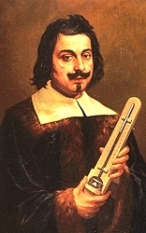Air (the atmosphere) has weight and presses on us.
- Who discovered it: Evangelista Torricelli
- Year of Discovery: 1643
On a clear October day in 1640, Galileo conducted a suction-pump experiment at a public well just off the market plaza in Florence, Italy. The famed Italian scientist lowered a long tube into the well’s murky water. From the well, Galileo’s tube draped up over a wooden cross-beam three meters above the well’s wall, and then down to hand-powered pump held by two assistants: Evangelista Torricelli, the 32-year-old the son of a wealthy merchant and an aspiring scientist, and Giovanni Baliani, another Italian physicist.
Torricelli and Baliani pumped the pump’s wooden handlebar, slowly sucking the air out of Galileo’s tube, pulling water higher into the tube. They pumped until the tube flattened like a run-over drinking straw. But no matter how hard they worked, water would NOT rise more than 9.7 meters above the well’s water level. It was the same in EVERY test.
Galileo proposed that –somehow– the weight of the water column made it collapse back to that height.
In 1643, Torricelli returned to the suction pump mystery. If Galileo was correct, a heavier liquid should reach the same critical weight and collapse at a lower height. Liquid mercury weighted 13.5 times as much as water. Thus, a column of mercury should never rise any higher than 1/13.5 the height of a water column, or about 30 inches.
Torricelli filled a six-foot glass tube with liquid mercury and shoved a cork into the open end. Then he inverted the tube and submerged the corked end in a tub of liquid mercury before he pulled out the stopper. As he expected, mercury flowed out of the tube and into the tube. But not all mercury ran out.
Torricelli measured the height of the remaining mercury column, 30 inches, as expected. Still, Torricelli suspected that the mystery’s true answer had something to do with the vacuum he had created above his column of mercury.
The next day, with wind and a cold rain lashing at the windows, Torricelli repeated his experiment, planning to study the vacuum above the mercury. However, on this day the mercury column only rose to a height of 29 inches.
Torricelli was perplexed. He had expected the mercury to rise to the same height as yesterday. What was different? Rain beat on the window as Torricelli pondered this new wrinkle.
What was different was the atmosphere, the weather. Torricelli’s mind latched onto a revolutionary new idea. Air, itself, had weight. The real answer to suction pump mystery lay not in the weight of the liquid, nor in the vacuum above it, but in the weight of the atmosphere pushing down around it.
Torricelli realized that the weight of the air in the atmosphere pushed down on the mercury in the tub. That pressure forced mercury up into the tube. The weight of the mercury in the tube had to be exactly equal to the weight of the atmosphere pushing down on the mercury in the tub.
When the weight of the atmosphere changed, it would push down wither a little bit more a little bit less on the mercury in the tub and drive the column of mercury in the tube wither a little higher or a little lower. Changing weather must change the weight of the atmosphere.
Torricelli had discovered atmospheric pressure and a way to measure and study it.
